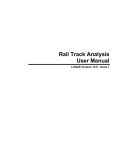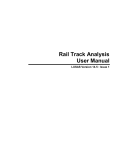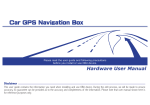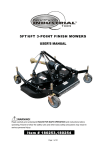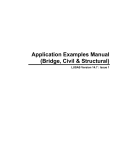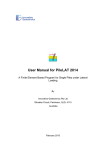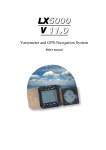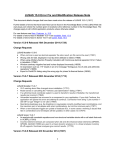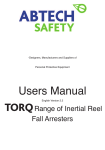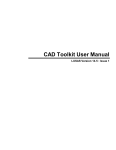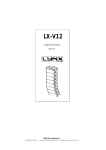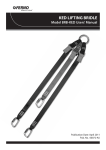Download Rail Track Analysis User Manual
Transcript
Rail Track Analysis User Manual LUSAS Version 14.2 : Issue 1 LUSAS Forge House, 66 High Street, Kingston upon Thames, Surrey, KT1 1HN, United Kingdom Tel: +44 (0)20 8541 1999 Fax +44 (0)20 8549 9399 Email: [email protected] http://www.lusas.com Distributors Worldwide Copyright ©1982-2008 LUSAS All Rights Reserved. Table of Contents Table Of Contents Rail Track Analysis 1 Introduction .......................................................................................................................... 1 UIC774-3 Code of Practice................................................................................................... 1 LUSAS Rail Track Analysis ................................................................................................. 4 The Rail Track Analysis Spreadsheet ................................................................................. 4 Worksheet 1: Spans and Embankment Lengths ...................................................................................... 5 Worksheet 2: Structure Definition .......................................................................................................... 6 Worksheet 3: Geometric Properties ........................................................................................................ 9 Worksheet 4: Material Properties ......................................................................................................... 12 Worksheet 5: Interaction and Expansion Joint Properties ..................................................................... 13 Worksheet 6: Thermal and Train Loading ............................................................................................ 16 Rail Track Analysis Menu Options .................................................................................... 17 Build Model Dialog .............................................................................................................................. 18 Apply Rail Loads Dialog ...................................................................................................................... 20 Extract Results To Microsoft Excel Dialog .......................................................................................... 21 Limitations of Use .............................................................................................................. 26 Appendix A: Verification Testing 27 Introduction ........................................................................................................................ 27 Description ......................................................................................................................... 27 Combination of Separate Thermal And Rail Loading ...................................................... 28 Analysis Of Combined Thermal And Rail Loading (One Step) ........................................ 36 Analysis Of Combined Thermal And Rail Loading Taking Account Of Effects Of Material Change Under Rail Loading ................................................................................ 38 Discussion ............................................................................................................................................ 41 Revisit Of UIC774-3 Test E1-3 Using The Separate And LUSAS Methods Of Analysis . 51 Separate Analyses ................................................................................................................................. 51 LUSAS Nonlinear Analysis .................................................................................................................. 53 Discussion ............................................................................................................................................ 55 Revisit Of UIC774-3 Test H1-3 Using The Separate And LUSAS Methods Of Analysis . 60 Separate Analyses ................................................................................................................................. 60 LUSAS Nonlinear Analysis .................................................................................................................. 62 Discussion ............................................................................................................................................ 64 Conclusions ....................................................................................................................... 66 Separate Thermal And Rail Loading Analysis ...................................................................................... 66 Concurrent Thermal And Rail Loading Analysis .................................................................................. 66 LUSAS Nonlinear Thermal And Rail Analysis With Material Change ................................................ 66 References ......................................................................................................................... 67 i Table Of Contents ii Introduction Rail Track Analysis Introduction The passage of one or more trains crossing a rail bridge causes forces and moments to occur in the rails that, in turn, induce displacements in the supporting bridge deck, bearings and piers. As part of the design process for rail bridges it is necessary to ensure that any interaction between the track and the bridge as a result of temperature and train loading is within specified design limits. UIC774-3 Code of Practice According to the Union Internationale des Chemins de fer (International Union of Railways) UIC774-3 Code of Practice, the track-structure interaction effects should be evaluated in terms of the longitudinal reactions at support locations, rail stresses induced by the temperature and train loading effects in addition to the absolute and relative displacements of the rails and deck. To assess the behaviour these interaction effects should be evaluated through the use of a series of nonlinear analyses where all thermal and train loads are taken into account. These loads should be: Z Z Z Z Z Z Z Rail Expansion Joint (If Present) Non-linear Springs Representing Ballast or Connection Track Z Z Z Z Z Z Z Z Z Z Z Z Z Z Bridge Deck Embankment Figure 1: Representation of Structural System for Evaluation of Interaction Effects 1 Rail Track Analysis User Manual Non-linear spring representing ballast/connection Z Z Z Track (rail) centreline Deck centreline Bearing Z Remaining Structure (Piers/Foundations) Longitudinal Schematic Of The Model Transverse Cross-Section Of Track-Deck-Bearing System Figure 2: Typical Model of Track-Deck-Bearing System The interaction between the track and the bridge is approximated in the UIC774-3 Code of Practice by a bilinear relationship as indicated in the following figure. The resistance of the track to the longitudinal displacements for a particular track type is a function of both the relative displacement of the rail to the supporting structure and the loading applied to the track. If the track is subjected to no train loads then the ultimate resistance of the track to relative movement is governed by the lower curve in the figure (based on the track type). Application of train loads increases the resistance of the track to the relative displacements and the upper curve should be used for the interaction between the track and bridge where these train loads are present – unloaded resistance is still used for all other locations. 2 UIC774-3 Code of Practice Resistance of rail to sliding relative to sleeper (Loaded Track) (Frozen ballast or track without ballast) Resistance (k) of the track Resistance of sleeper in ballast (Loaded Track) Resistance of rail to sliding relative to sleeper (Unloaded Track) (Frozen ballast or track without ballast) Resistance of sleeper in ballast (Unloaded Track) u0(Frozen/No Ballast) u0(Ballast) Displacement (u) Figure 3: Resistance (k) of the Track per Unit Length versus Longitudinal Relative Displacement of Rails The values of displacement and resistance to use in these bilinear curves are governed by the track structure and maintenance procedures adopted and will be specified in the design specifications for the structure. Typical values are listed in the Code of Practice for ballast, frozen ballast and track without ballast for moderate to good maintenance. According to the UIC774-3 Code of Practice there is no requirement to consider a detailed model of the substructure (bearing-pier-foundation and bearing-abutmentfoundation systems) when „standard‟ bridges are considered, instead this can be modelled simply through constraints and/or spring supports that approximate the horizontal flexibility due to pier translational, bending and rotational movement. The LUSAS Rail Track Analysis option allows this type of analysis to be carried out where the behaviour of the bearing and the pier/abutment-foundation are individually specified but also provides the capability of explicitly modelling the bearingpier/abutment-foundation systems where each component is defined, including the height and properties of the pier/abutment. 3 Rail Track Analysis User Manual LUSAS Rail Track Analysis The Rail Track Analysis option in LUSAS provides the means to automate the finite element analyses required for conducting bridge/track interaction analyses in accordance with the UIC774-3 Code of Practice. The key features are: The Rail Track Analysis Spreadsheet A Microsoft Excel spreadsheet is used to define the data from which a LUSAS finite element model is built and a track/bridge interaction analysis carried out. The spreadsheet is separated into a number of worksheets that relate to particular aspects of the Rail Track Analysis input requirements. These worksheets cover: For each worksheet comments are included to advise on the appropriate input to the spreadsheet. These can be seen when hovering the mouse cursor over the cell of interest. The template for the input spreadsheet is located in the \<Lusas Installation Folder>\Programs\Scripts\User directory. Initially this template contains data that reproduces the E1-3 UIC test case model outlined in the code of practice as an illustration and should be edited and saved to the working directory in order to carry out analyses. Note. All of the data entered into the Microsoft Excel spreadsheet should be in metric units. The required units are indicated in the various sections of the spreadsheet and should be adhered to for the correct modelling of the interaction analysis. When the model is built, all input will be converted to SI units of N, m, kg, C and s. 4 The Rail Track Analysis Spreadsheet Worksheet 1: Spans and Embankment Lengths Figure 4: Definition of Number of Spans, Tracks and Embankment Lengths This worksheet defines the global arrangement details of the bridge structure. The number of spans is initially limited to 100 but can be increased by modifying the Structure Definition worksheet as outlined in the following section. The number of tracks can be set as either one or two. For two tracks, one will take the braking load of a trainset and the other will take the acceleration load of a separate trainset. The final input in this worksheet is the lengths of the left and right embankments. These lengths should be sufficiently long to allow the trainset loading to be placed in the model and, according to the UIC774-3 Code of Practice, should be greater than 100m (Clause 1.7.3). Left Embankment Right Embankment Figure 5: Left and Right Embankments in Model 5 Rail Track Analysis User Manual Worksheet 2: Structure Definition Figure 6: Structure Definition The structure definition worksheet allows the geometry of the bridge to be input span by span. For each span the spreadsheet allows the definition of the left pier/abutment, up to eight internal piers and the right pier/abutment, each with their own support / bearing characteristics. These can include the physical modelling of the piers (by entering data into the pier height, geometric and material assignment columns) or be left blank if the behaviour of the combined pier/foundation system is to be incorporated into the spring support only. Note The pier properties for the last pier of one span must exactly match the properties defined for the next span or an error will be reported when the Microsoft Excel spreadsheet is used to carry out the analysis. When the pier/foundation system is modelled as a spring this spring can be calculated by combining the component movements associated with the pier as indicated below and described further in the UIC774-3 Code of Practice: total p h b where dp = displacement at top of support due to elastic deformation d = displacement at top of support due to rotation of the foundation 6 The Rail Track Analysis Spreadsheet dh = displacement at top of support due to horizontal movement of the foundation db = relative displacement between the upper and lower parts of bearing (Only included if bearings effects lumped into support conditions) and the total spring stiffness is calculated from: H total (in kN/mm) p h H K H H H Figure 7: Component Behaviour for Calculating Support Stiffness Note If the piers are modelled in the analysis the rotation of the foundation is assumed to be zero in the analysis. This can be adjusted by modifying the support conditions manually after a temperature only analysis has been performed (see user interface discussions) In addition to the general arrangement or the piers, supports and bearings, the gaps between the piers are also defined in this worksheet and should be a positive number greater than zero (in metres). The final entries in the worksheet relate to the geometric and material properties to assign to the spans. Different properties can be assigned to each segment of the span but continuously varying properties cannot be modelled. All of the geometric and material properties used in the structure definition must be defined in the geometric and material property worksheet tables described later in this manual. Increasing the number of spans modelled If more than 100 spans are required the Microsoft Excel spreadsheet can be modified. To do this, scroll to the end of the Structure Definition worksheet and select the last complete span definition as indicated on the figure below. 7 Rail Track Analysis User Manual Figure 8: Selection and Copying of Structure Definition Worksheet to Increase Number of Spans Copy and paste this section as many times as required at the end of the worksheet, ensuring that the row formatting is not altered as indicated below. If successful, the span number should be correctly calculated for the added entries. The number of spans in the first worksheet of the spreadsheet can now be increased to the number of spans added to the structure definition. 8 The Rail Track Analysis Spreadsheet Figure 9: Pasting of Additional Spans to Ensure Formatting Maintained Worksheet 3: Geometric Properties Figure 10: Geometric Properties Table for Structure 9 Rail Track Analysis User Manual The geometric properties worksheet should list all of the section properties required for the modelling of the structure and the unique ID numbers must include all of the geometric properties that have been assigned in the Structure Definition worksheet. The properties should be entered in metres and are all standard LUSAS values except the Depth of Section to Support entry that is needed by the model building to ensure the support conditions occur at the correct elevation. Eccentricity All eccentricity in the modelling is defined relative to the nodal line of the track/rail and therefore a positive eccentricity will place a section below this line as indicated in the following figure. If an eccentricity is entered for the geometric property of the rail then the neutral axis of the rail will be offset from this nodal line based on the positive sense described. For this reason the eccentricity of the rail should generally be set to zero for all cases. Notes The number of entries can be increased by adding data to the bottom of the table. Data input will terminate on the first blank ID number in column B The depth of section should not be defined for geometric properties assigned to piers The eccentricity between the rail/slab indicated in the figure is defined later in the interaction worksheet and should not be defined as a geometric property. Eccentricity Of Section (+ve Sense) Eccentricity Between Rail/Slab (+ve Sense) Nodal Line Of Track/Rail Neutral Axis Of Section Location Of Support Conditions Depth Of Section Figure 11: Eccentricity Definition for Geometric Properties and Depth of Section Element Orientations The orientations of the sectional properties should obey the element local axes indicated in the following figure where the double-headed arrow indicates the element local x-axis, the single headed arrow indicates the element local y-axis and the line without an arrowhead indicates the element local z-axis. For both the spans and the 10 The Rail Track Analysis Spreadsheet piers the element local y-axis is orientated into the lateral direction for the bridge with the local z-axis orientated vertically for the spans and in the longitudinal direction for the piers. Figure 12: Beam Element Local Axes for Span and Pier Modelling 11 Rail Track Analysis User Manual Worksheet 4: Material Properties Figure 13: Material Properties Table for Structure The material properties worksheet should list all of the material properties required for the modelling of the structure and the unique ID numbers must include all of the material properties that have been assigned in the Structure Definition worksheet. The elastic properties are all standard LUSAS values which should be entered in Newtons, millimetres and kilograms. The mass density () is not used in the analysis but is provided to allow the model to be solved with self-weight loading and for it to be combined with the thermal/train loading effects covered in these analyses. Note. The number of entries can be increased by adding data to the bottom of the table. Data input will terminate on the first blank ID number in column B. 12 The Rail Track Analysis Spreadsheet Worksheet 5: Interaction and Expansion Joint Properties Figure 14: Interaction Properties Between the Track/Bridge and Expansion Joint Definition The main bilinear interaction effects for the track/bridge interaction are defined in this worksheet along with additional properties associated with the rail/track. These include the eccentricity between the rail/slab (see Figure 11 and the Geometric Properties section) and the presence of any rail expansion joints. Eccentricity Between Rail/Slab The eccentricity between the rail/slab is used to define the distance between the nodal line or the rail/track and the top of the bridge slab/deck as indicated in Figure 11. In general, all eccentricities will be positive in the modelling unless the neutral axis of the structure section is above the level of the rails. This only happens for certain types of structures and the definitions of eccentricity should generally follow the sign conventions defined in the following figure. 13 Rail Track Analysis User Manual Eccentricity Of Section (+ve) Eccentricity Between Rail/Slab (+ve) Nodal Line Of Track/Rail Neutral Axis Of Section Location Of Support Conditions Depth Of Section Eccentricity Definitions (Section Neutral Axis Below Rail Level, Support At Base) Eccentricity Of Section (-ve) Eccentricity Between Rail/Slab (+ve) Neutral Axis Of Section Nodal Line Of Track/Rail Location Of Support Conditions Depth Of Section Eccentricity Definitions (Section Neutral Axis Above Rail Level, Support At Base) Figure 15: Sign Conventions for Eccentricity Definition The bilinear interaction properties are derived from the bilinear curves defined in the UIC774-3 Code of Practice. Properties are entered for both the unloaded and loaded states with the contact stiffness defined in kN/mm per metre length of track, the liftoff force (onset of plastic yield) defined in kN per metre length and the lift-off springs defined as a small value so there is no stiffness once plastic yielding has started. The values in Figure 14 are for unballasted track where: u0 05 . mm k = 40kN / m (Unloaded) k = 60kN / m (Loaded) The contact stiffness is calculated directly from: k Contact Stiffness = u0 14 The Rail Track Analysis Spreadsheet The transverse spring properties of the interaction should always be infinite (as the analysis is two-dimensional even though the elements are three-dimensional) but the vertical spring properties can be adjusted from this to include vertical deformation effects of the ballast. If this type of analysis is carried out, care must be taken to ensure that the spring remains in the elastic regime. This is achieved by setting a very high value for the lift-off force (1.0E12 kN/mm per metre length for example) and ensuring that the lift-off springs are set to the same stiffness value as the contact stiffness. Defining Rail Expansion Joints If rail expansion joints are present in the bridge then the information for these can be entered into the worksheet for each track. The data input takes the form of a unique positive ID number that is placed in column B, the positions and initial gaps. The expansion joint data will be read from the spreadsheet until a blank ID entry is detected. For each unique ID number an expansion joint can be defined for either track by entering the position in metres from the start of the left-hand embankment and initial gap in millimetres. Figure 16: Sample Expansion Joint Definitions 15 Rail Track Analysis User Manual Worksheet 6: Thermal and Train Loading Figure 17: Definition of Thermal and Train Loading for Structure The temperature effects in the rails for a continuously welded rail (CWR) track do not cause a displacement of the track and do not need to be considered (UIC774-3 Clause 1.4.2). For all other tracks the change in temperature of the bridge deck and rails relative to the reference temperature of the deck when the rail was fixed needs to be considered in accordance to the code of practice and design specifications. The temperature loads for both the slab/deck and the rail should be entered (zero if not required) in Celsius (degrees centigrade) where temperature rises are entered as positive values and temperature drops are entered as negative values. The train loading is defined in terms of the type, track, position and magnitude. The type may be Braking, Acceleration or Vertical with the first character governing the type detection and allows a more descriptive definition to be entered if required. The track to be loaded must indicate a valid track based on the data entered into the Number of Spans, Tracks And Embankment Lengths worksheet described earlier. The start and end positions of the loading should be defined in metres relative to the left-hand end of the left embankment which is at position 0.0m and must remain within the overall length of the model including embankments (refer to the Spans, Tracks and Embankments worksheet which reports the total length of the model). The final data required is the amount of load to apply to the rail in kN per metre length. For vertical loads a positive value indicates that the load acts in a downward sense and for horizontal (braking and accelerating) loads a positive value indicates that the load acts towards the right embankment. 16 Rail Track Analysis Menu Options As many rail/train loads as required can be defined in the spreadsheet with data input terminating when blank data is detected in the loading type column. This allows more complex loading patterns to be defined such as those illustrated below Figure 18: More Complex Train Loading Definition in Spreadsheet Rail Track Analysis Menu Options The Rail Track Analysis option is accessed through the Bridge menu by selecting the Rail Track Analysis UIC774-3 entry. This menu entry provides the following three options: 17 Rail Track Analysis User Manual Build Model Dialog Figure 19: UIC774-3 Model Builder Dialog If batch processing of multiple models is being performed then a batch text file listing the Microsoft Excel spreadsheets to use for defining the models should be entered into the box (must have a *.txt file extension). The batch text file can be entered explicitly into the dialog or located using the Browse… button and selecting “Batch text file (*.txt)” as the file type. The format of the batch text file is indicated below and simply contains a list of the Microsoft Excel files to build the models from with one file per line. If no directory structure is defined for the files then the current working directory will be assumed to contain the files, otherwise they may exist at any directory level on the computer system. If a spreadsheet file cannot be found or contains invalid data it will be skipped in the batch processing and an error reported in the “UIC7743_BuildModel.log” file created in the current working directory. Blank lines are ignored and batch processing will terminate at the end of the batch text file. The number of analyses in the batch process is unlimited. 18 Rail Track Analysis Menu Options Bridge1.xls ..\SomeDirectory\Bridge2.xls D:\Project\Spreadsheet\Bridge3.xls Figure 20: Example Batch Text File With Three Bridges To Build Note. For large bridges and/or embankments the use of small element sizes can generate excessively large models which take significant time to manipulate / solve. Use of element sizes below 1.0m should be used with caution. If only a single rail loading configuration is going to be analysed for a particular model then this option should be switched on. If, on the other hand, a range of rail loading configurations needs to be applied to a model (for different train positions with varying braking / accelerating loading configurations) then this option should be turned off to allow the rail loads to be applied separately by the Apply Rail Loads dialog described below. Building a model to solve only temperature effects also allows the model to be updated prior to applying the rail loading. A situation where this may be needed is the case of a mixed bridge type (for example, one having concrete and steel sections) where the temperature loading of the bridge/deck cannot be classified by the single temperature change available in the Microsoft Excel spreadsheet. If only the temperature model is built, additional temperature loading attributes can be defined and assigned to the temperature loadcase prior to the rail load application. This will also allow the support conditions to be modified for pier foundations that require rotational stiffness rather than rigidity – see the discussion of Structure Definition section of the Microsoft Excel spreadsheet. Note. The overall structure of the model should not be significantly modified, nor the loadcase layout, otherwise the application of the rail loading may fail. 19 Rail Track Analysis User Manual Apply Rail Loads Dialog Figure 21: UIC774-3 Apply Rail Loads Dialog If the bridge model was built and solved with only the temperature loads (Apply temperature and rail loads in same analysis turned off in model building dialog) then this model can subsequently be used for applying rail load configurations using this dialog. The dialog should not be used for models that have been built with both the temperature and rail loading applied and will report an error if attempted. If multiple models and/or multiple rail load configurations are to be analysed then only the batch text file (which must have a *.txt file extension) listing the information 20 Rail Track Analysis Menu Options required by the software should be entered into this box. Alternatively, the Browse… button can be used, selecting “Batch text file (*.txt)” as the file type. For each model/rail configuration analysis the batch text file should contain a separate line of data. Each line should specify the original temperature model, the new combined loading model to create and the Microsoft Excel spreadsheet that contains the rail configuration definition. Each item on a line should be TAB delimited to allow spaces to be used in the filenames. An example batch text file is shown below. Bridge1.mdl Bridge1_RailConfig1.mdl Bridge1_RailConfig1.xls Bridge1.mdl Bridge1_RailConfig2.mdl Bridge1_RailConfig2.xls Bridge1.mdl Bridge1_RailConfig3.mdl Bridge1_RailConfig3.xls Bridge1.mdl Bridge1_RailConfig4.mdl Bridge1_RailConfig4.xls Bridge2.mdl Bridge2_RailConfig1.mdl Bridge2_RailConfig1.xls Bridge2.mdl Bridge2_RailConfig2.mdl Bridge2_RailConfig2.xls Bridge3.mdl Bridge3_RailConfig1.mdl Bridge3_RailConfig1.xls Figure 22: Sample Rail Loading Batch Text File In the above example, three different bridge deck temperature models have been selected and four rail load configurations analysed for the first, two rail load configurations for the second and one rail load configuration for the third. The number of entries in the batch text file is unlimited and batch processing will terminate once the end of the file is reached. If any analysis fails due to missing or invalid files an error will be reported to the “UIC774-3_RailLoads.log” file in the current working directory. Extract Results To Microsoft Excel Dialog Figure 23: UIC774-3 Post Processor Dialog A dedicated post-processing dialog is provided that allows the automatic extraction of the results from the track/bridge interaction analysis to a Microsoft Excel spreadsheet. 21 Rail Track Analysis User Manual On start-up, the dialog will inspect the active model to ensure that these are results present and also detect whether the UIC774-3 groups defined during the model building process are present. For this reason any manual editing of the model should be kept to a minimum and the “Rail 1”, “Rail 2” and “Spans” groups should not be modified. If all of the groups are found in the model separate worksheets are generated for the results in the tracks/rails and spans. If one or more of these groups are absent from the model then the dialog will attempt to use the current selection in Modeller to perform the post-processing. If the selection is used, this must contain lines that have 3D engineering thick beam elements assigned to them. Output Format On clicking the OK button the post-processor will extract the results from all of the results loadcases along with all envelopes (without association) and basic combinations defined in the model file. If multiple results files are loaded on top of the model, for example if multiple rail load configurations have been analysed and the results loaded into Modeller for enveloping / post-processing, then the results loadcases for all these results files will be extracted into the Microsoft Excel spreadsheet. Microsoft Excel is currently limited to 256 columns in a worksheet and this limits the results processing to only 20 loadcases/envelopes/combinations. If this limit is exceeded the results post-processor will allow the extraction of the envelopes/combinations into one Microsoft Excel spreadsheet and all of the results loadcases into a separate spreadsheet (with the limit of 20). The results output format is indicated in the following two figures. 22 Rail Track Analysis Menu Options Figure 24: Microsoft Excel Spreadsheet Generated by Processing UIC774-3 Groups Figure 25: Microsoft Excel Spreadsheet Generated by Processing Selection 23 Rail Track Analysis User Manual The results are currently output as displacements in the longitudinal (X), vertical (Y) and major bending rotations (RZ) along with axial forces (Fx), shear forces (Fz) and bending moments (My). These results can be further post-processed in Microsoft Excel or a separate package to determine quantities such as the axial stress in the rails of the track. The following figures show the axial stress in the rails for thermal effects only and combined effects for a sample structure. Figure 26: Thermal Effects Only in Rails 24 Rail Track Analysis Menu Options Figure 27: Combined Effects of Temperature and Train Loading in Rails 25 Rail Track Analysis User Manual Limitations of Use Centreline Track 1 Centreline Deck Offset Track 1 Centreline Track 2 Offset Track 2 Centreline Abutment/Pier Offset Abutment/Pier Offset Bearing 1 Offset Bearing 2 Offset Bearing CL Centreline Bearings Figure 28: Offsets of Tracks/Bearings/Piers from Centreline Of Deck 26 Introduction Appendix A: Verification Testing Introduction This appendix includes some background to the calculation of the UIC774-3 track/bridge interaction analyses in LUSAS. It explains why results from running a LUSAS nonlinear analysis that considers all thermal and train effects for the test cases in question in one analysis does not over-predict the rail stresses occurring under the combined thermal and rail loading - unlike results from simplified hand calculations or from results from other finite element analysis software systems where thermal and train effects are carried out by running separate nonlinear analyses. From the verification testing carried out we can say that… Even though a computer program may be validated against the standard test cases in the UIC774-3 code of practice, in situations when combined thermal and train loading from separate analyses gives track-structure interaction forces that exceed the stated yield resistance of the trackrestraint system (i.e. the ballast) then the separate analysis method will potentially over predict the rail stresses unless the loaded track yield surface is reduced by the mobilised track resistance over the extent of the train loading. Rail stress over-predictions of up to 30% have been seen when thermal and train loading results are combined from separate analyses. Description The rail track analysis (UIC774-3) option in LUSAS allows the construction and solution of finite element models to study the interaction between the rail track and a bridge. This forms an essential part of the design process as the stresses within the rails of the tracks must remain within specified limits based upon the design and the state of maintenance. A number of calculation methods are available and each of these can lead to a slightly different solution for the combined thermal and rail loading condition. Each of these methods (except the hand calculation) has been investigated in this technical note prior to carrying out the analysis in LUSAS using the rail track analysis option. 27 Rail Track Analysis User Manual The Hwashil Viaduct, a railway bridge in South Korea, has been used for this testing with continuous welded rail (CWR) and thermal effects only present in the structure for the following analyses: In addition, two of the UIC standard test cases have also been reinvestigated to demonstrate that these results can be matched even if the analysis type is potentially invalid prior to providing guidance and conclusions on this type of analysis. These analyses were: Combination of Separate Thermal And Rail Loading In this form of analysis two or more separate analyses are carried out with each analysis considering a different loading regime to the structure. This is the simplest form of analysis of the track/bridge interaction as it assumes that superposition is valid for a nonlinear system and, according to the UIC774-3 code of practice, can generally overestimate the rail stresses with percentage errors up to 20 to 30% be it through hand calculation or computer methods. This analysis procedure is replicated in LUSAS by performing two separate nonlinear analyses. The first considers only the thermal effects and uses the unloaded resistance bilinear curve for modelling the interaction between the track and bridge. The results of this analysis are identical for the two tracks in the model and so only the results for the first track are presented in the following figure. 28 Combination of Separate Thermal And Rail Loading Figure 29: Axial Force In Rails Due To Thermal Effects Only These thermal effects give a peak compressive rail stress of 46.06 N/mm2 (F/A = 0.7065E+06/0.0153389). Having carried out the thermal analysis the rail loading will be considered in a separate analysis (both horizontal and vertical loading) for the „worst‟ conditions. This rail load analysis is again a nonlinear analysis but it has no knowledge of the history from the thermal effects and therefore assumes a zero strain initial state prior to the application of the load. In addition to this unstrained condition, the loaded resistance bilinear curve is used underneath the locations of the rail loading while the unloaded lengths of track use the unloaded resistance bilinear curve. The results from the rail loading analyses are presented in the following two figures, the first being the track that has the braking train loading and the second being the track that has the accelerating train loading. 29 Rail Track Analysis User Manual Figure 30: Axial Force In Rails Due To Braking Train Loads On Track 1 Figure 31: Axial Force In Rails Due To AcceleratingTrain Loads On Track 2 30 Combination of Separate Thermal And Rail Loading From these results the peak compressive rail stresses for the two tracks are as follows: Track 1: 48.93 N/mm2 Track 2: 57.59 N/mm2 A basic combination of the loading can be defined to add the results from the thermal and rail loading analyses together which gives the following track peak compressive stresses (see following figures): Track 1: 94.99 N/mm2 Track 2: 103.66 N/mm2 Figure 32: Axial Force In Rails Due To Combined Thermal And Train Loads In Track 1 31 Rail Track Analysis User Manual Figure 33: Axial Force In Rails Due To Combined Thermal And Train Loads In Track 2 Inspection of the two plots shows that there is a reduction in the axial force / rail stresses over the first two span transition piers towards the left end of the structure for track 1 only (subjected to the braking train). The following figures show zoomed plots of the rail axial force for this location with the thermal diagram showing identical values either side of these piers for all of the spans in the model. The reason for the reduction in the axial force becomes clear from the axial force diagram for the train braking load alone, Figure 35, where the axial force has a positive peak over the span transition piers which is not symmetrical. Looking at the transition from the first span to the second (2nd pier from left abutment) the axial force in the rail over the end of the first span is equal to a tension force of 362.4 kN while the axial force over the start of the second span is equal to a tension force of 344.7 kN. Like for like comparison of the elements a certain distance from the pier for each span shows that the second span is consistently lower and this difference has caused the nonsymmetric nature of the combined axial force / rail stress diagram over the span transition piers. 32 Combination of Separate Thermal And Rail Loading Figure 34: Zoomed Axial Force In Rails Due To Thermal Effects Only Figure 35: Zoomed Axial Force In Rails Due To Braking Train Loads On Track 1 33 Rail Track Analysis User Manual NOTE: When viewing this axial force diagram it should be recognised that while the first two spans (2*25m each) have identical geometry and pier/bearing properties, the first span segment of the first span does not carry any of the braking train load and this is contributing to the difference in the behaviours observed over the piers. Looking at the yield in the track/bridge interaction for this track, Figure 36, the reason for the differences in axial force either side of the pier becomes clear as yielding has occurred to the left but not to the right of the span transition pier for these first two spans. Figure 36: Yield In Track/Bridge Interaction Due To Train Braking Load On Track 1 34 Combination of Separate Thermal And Rail Loading Looking now at the second track where the accelerating train is at the right-hand end of the structure, the interaction remains unloaded and so the rail axial force / stress observed it basically due to the bending of the bridge deck due to the action of the braking train load on the other track. Because there is no direct loading to the track then the axial force in the rail displays a continuous variation over the span transition piers and therefore no reduction is observed in the combined diagram for this track. Figure 37: Zoomed Axial Force In Rails Due To Accelerating Train Loads On Track 2 Looking again at the yielding, Figure 38, the difference between this track and the one with the braking train becomes obvious as, without the action of any train load over the span transition for this track, the yield is roughly symmetrical and occurring across the transition between spans – colour change indicates changing yield direction. This yield over the whole region of the span transition is the whole reason why a smooth behaviour is observed in the rail force / stress in the second track as opposed to the first track that has the braking train load. 35 Rail Track Analysis User Manual Figure 38: Yield In Track/Bridge Interaction Due To Train Acceleration Load On Track 2 Analysis Of Combined Thermal And Rail Loading (One Step) In this form of analysis a single nonlinear analysis is carried out where the thermal and rail loading are applied concurrently to the model. In terms of the track/bridge interaction, the resistance bilinear curves used in the modelling are determined by the positioning of the rail loading so that loaded properties are used where the rail loading is applied and unloaded properties everywhere else. As with the separate method highlighted above, this analysis ignores any initial straining of the track/bridge interaction under pure thermal loading and therefore assumes that the loaded resistance properties are active under the thermal loading over the extent of the train loading. The results from the analysis are shown in the following figures and give the following results for the track peak compressive stresses: Track 1: 85.6 N/mm2 Track 2: 100.6 N/mm2 NOTE: For this analysis the reduction in axial force / rail stress is not observed at the span discontinuities towards the left end of the structure. 36 Analysis Of Combined Thermal And Rail Loading (One Step) Figure 39: Axial Force In Rails Due To Combined Thermal And Train Loads In Track 1 (One Step) Figure 40: Axial Force In Rails Due To Combined Thermal And Train Loads In Track 2 (One Step) 37 Rail Track Analysis User Manual Analysis Of Combined Thermal And Rail Loading Taking Account Of Effects Of Material Change Under Rail Loading The previous two analysis methods fail to take account of the train rail loading being applied to the rail when it has already undergone movement/stresses due to thermal effects alone. In this current form of analysis (implemented into LUSAS) the initial thermal effects are considered prior to the application of the train rail loading and the behaviour under this rail loading takes account of this history. To illustrate the analysis, consider the following: When the train is not on the track the stresses in the rails are governed purely by the thermal effects. For the Hwashil Viaduct the thermal effects due to the bridge only are considered and therefore the action of this causes the structure to move thus inducing relative movement between the track and the bridge and therefore an associated stress in the rail. For this condition the unloaded resistance properties apply across the whole extent of the track As the train load arrives over a particular part of the bridge the initial relative movement of the track/bridge from the thermal effects remains and therefore the application of the train load changes the resistance state from unloaded to loaded without the loss of this initial rail stress caused by the relative movement The train load causes increased slip of the interaction based on the loaded resistance with the end of the force-displacement curve for the unloaded resistance used as the starting point for the loaded resistance If it was modelled, the departure of the train load would change the resistance state back to unloaded 38 Analysis Of Combined Thermal And Rail Loading Taking Account Of Effects Of Material Change Under Rail Loading Yield Of Loaded Track Force Loaded Resistance Under Thermal And Train Load Yield Of Unloaded Track Unloaded Resistance During Thermal Load Force-strain corresponding to applied thermal loading (no train) Strain Figure 41: Representation Of Transition From Unloaded To Loaded In LUSAS The key is that the interaction resistance switches from unloaded to loaded the moment the rail load arrives thereby „locking in‟ any initial movement that has occurred under the thermal loading until that rail load departs. The results from this form of analysis are shown in the following figures which give peak compressive rail stresses of: Track 1 and 2 (Thermal Only): 46.06 N/mm2 Track 1 (Thermal and Train): 79.08 N/mm2 Track 2 (Thermal and Train): 92.58 N/mm2 39 Rail Track Analysis User Manual Figure 42: Axial Force In Rails Due To Thermal Only Figure 43: Axial Force In Rails Due To Combined Thermal And Train Loads In Track 1 40 Analysis Of Combined Thermal And Rail Loading Taking Account Of Effects Of Material Change Under Rail Loading Figure 44: Axial Force In Rails Due To Combined Thermal And Train Loads In Track 2 The analyses produced using this method can give a lower peak compressive stress in the rails than observed using the other approaches but agrees closely with the published test cases using rigorous methods in UIC774-3 as observed in the following sections for test E1-3 and H1-3. Discussion The peak compressive stresses in track/rail 2 which has the accelerating load and track/rail 1 that is subjected to the braking train show differences in the peak compressive stress in the rails based on the position of the train loads used in the analysis. As the loading and geometry of the models are identical the differences can only be associated with the track resistance modelling/behaviour. It has been noted previously in Section 0 above that the transition from unloaded resistance to loaded resistance is only incorporated into the LUSAS modelling so this track resistance is investigated by looking at the yield under the effects of the rail loading. Looking first at the second track/rail that has the accelerating load, the yielding occurring from the three analyses are shown in the following figures. Comparing the yield layout for the LUSAS analysis (Figure 48) and the concurrent thermal/train loading analysis (Figure 47) shows that the overall yield behaviour is almost identical, hence the similarity in the peak compressive rail stresses obtained albeit with the LUSAS value slightly lower. Looking now at the separate analysis, the yield layout for both the LUSAS and concurrent thermal/train loading analyses are comparable 41 Rail Track Analysis User Manual with the yield layout for thermal effects alone (Figure 45) with very little yield associated with the accelerating rail load analysis (Figure 46). This is primarily due to the accelerating train only just entering the bridge with the majority of the loads over the right approach embankment which are vertical not horizontal. Figure 45: Track/Rail 2 Yield Due To Thermal Load On Track Alone Figure 46: Track/Rail 2 Yield Due To Accelerating Train Loads On Track 2 – Separate Analysis 42 Analysis Of Combined Thermal And Rail Loading Taking Account Of Effects Of Material Change Under Rail Loading Figure 47: Track/Rail 2 Yield Due To Accelerating Train Loads On Track 2 Thermal And Rail Applied Concurrently Figure 48: Track/Rail 2 Yield Due To Accelerating Train Load On Track 2 - LUSAS Combined Analysis 43 Rail Track Analysis User Manual Looking at what is effectively happening in these analyses, Figure 49, the concurrent loading analysis uses the loaded resistance throughout the analysis and follows the loaded stiffness curve from the origin and potentially gives the location indicated on the plastic part of this curve as illustrated with a force in the interaction limited to the resistance of the loaded track. For the separate analysis, the thermal effects use the unloaded curve and the behaviour of this part of the analysis is limited by the resistance of the unloaded track. Under these conditions the analysis may give a location indicated by the „Thermal Alone‟ point on the unloaded curve. Separate consideration of the train loading effectively places the origin of the loaded bilinear curve at this „Thermal Alone‟ position and any loading could potentially give the location indicated by the „Separate Train Load Added To Thermal‟ position. This could give an apparent increase in the resistance of the track and therefore increase rail stresses in the loaded track. Separate Train Load Added To Thermal Concurrent thermal and train loading (loaded resistance) Thermal Alone Limit of resistance of unloaded track Loaded Stiffness Limit of resistance of loaded track Force Apparent increase in resistance of loaded track Strain Unloaded stiffness (Thermal) Figure 49: Illustration Of Behaviour Of Separate Analysis Vs. Concurrent Thermal And Rail Loading 44 Analysis Of Combined Thermal And Rail Loading Taking Account Of Effects Of Material Change Under Rail Loading Similar comparisons can be made between the separate analysis and the LUSAS analysis - Figure 50. While both of these effectively use the „Thermal Alone‟ location as an origin for the loaded resistance curve, the key difference between the two approaches is that the LUSAS analysis enforces the track resistance at which plasticity occurs instead of allowing the potential for an apparent increase in the track resistance equal up to the unloaded plus the loaded track resistance. These differences have affected the peak compressive rail stresses in the track subjected to accelerating train loads with all three analyses predicting stresses in the range of 93 to 103 N/mm2. Separate Train Load Added To Thermal LUSAS Analysis Thermal Alone Limit of resistance of unloaded track Loaded Stiffness Limit of resistance of loaded track Force Apparent increase in resistance of loaded track Strain Unloaded stiffness (Thermal) Figure 50: Illustration Of Behaviour Of Separate Analysis Vs. LUSAS Analysis Looking now at the track/rail that has the braking train on it, the following figures show the same yield plots for this track/rail resistance. The immediate observation is the different yield behaviour observed for the LUSAS analysis. Looking initially at the separate analysis and the concurrent thermal and rail loading analysis the yielding observed in the thermal alone for the separate analysis (Figure 51) shows close similarity to the yielding observed when the thermal and train loading are applied concurrently (Figure 53) – minimal yielding is observed under the action of the train load alone in the separate analysis (Figure 52). 45 Rail Track Analysis User Manual Concentrating on the LUSAS analysis, the front of the braking train load is just over the right end of the structure and the carriages cover most of the remaining bridge. This has the effect, unlike the accelerating track, of changing nearly all of the resistance from unloaded to loaded for this track over the bridge and therefore the interaction is no longer under yield because the loaded resistance now governs plastic yield. The LUSAS analysis however does not display the possible apparent increase in the resistance of the track that can be observed with the separate analysis method. This means the track interaction around the front of the braking train resisting the movement of the rails cannot sustain the same level of loading and therefore yield to a larger extent than observed in the separate analysis, thereby reducing the compressive stress in the rails underneath the train – compare Figure 52 and Figure 54 where the yielding underneath the braking train is greater for the LUSAS analysis than in the separate rail load analysis. Figure 51: Track/Rail 1 Yield Due To Thermal Load On Track Alone 46 Analysis Of Combined Thermal And Rail Loading Taking Account Of Effects Of Material Change Under Rail Loading Figure 52: Track/Rail 1 Yield Due To Braking Train Loads On Track 1 – Separate Analysis Figure 53: Track/Rail 1 Yield Due To Braking Train Loads On Track 1 - Thermal And Rail Applied Concurrently 47 Rail Track Analysis User Manual Figure 54: Track/Rail 1 Yield Due To Braking Train Load On Track 1 - LUSAS Combined Analysis 48 Analysis Of Combined Thermal And Rail Loading Taking Account Of Effects Of Material Change Under Rail Loading Looking at the behaviour of the track interaction for the separate analysis we can plot the values of the force per metre length for the track subjected to the braking train loads. Figure 55 and Figure 56 show the forces per metre length for the thermal loading and the train braking loading for the separate analyses. Clearly, near the righthand abutment, the force per metre length under the thermal loading is equal to 40kN/m and due to the train loading is equal to 60kN/m. Combination of these two results means that the track interaction has mobilised 100kN/m in this region when it is actually only able to mobilise 60kN/m based on the loaded track resistance bilinear curve – the separate analysis method is giving an apparent increase in the loaded track resistance that can be mobilised before plastic yielding occurs. This apparent increase in the loaded track resistance has the consequence of allowing the rail stresses to increase beyond the value that would occur if the true loaded track resistance was used as in the LUSAS modelling where the track resistance is correctly limited to the loaded value of 60kN/m – Figure 57. NOTE: This difference in the amount of track resistance that can be mobilised in the loaded condition is the main reason for the differences in the solutions obtained for the separate and LUSAS methods and demonstrates that the correct modelling of the interaction is critical to the solution. Figure 55: Force In Interaction At Right-Hand End Of Structure Where Peak Compressive Stresses Occur In The Rail - Track 1 – Separate Thermal Loading (N/m length) 49 Rail Track Analysis User Manual Figure 56: Force In Interaction At Right-Hand End Of Structure Where Peak Compressive Stresses Occur In The Rail - Track 1 - Separate Train Loading (N/m length) Figure 57: Force In Interaction At Right-Hand End Of Structure Where Peak Compressive Stresses Occur In THe Rail - Track 1 – LUSAS Nonlinear (N/m length) 50 Revisit Of UIC774-3 Test E1-3 Using The Separate And LUSAS Methods Of Analysis Revisit Of UIC774-3 Test E1-3 Using The Separate And LUSAS Methods Of Analysis The standard UIC774-3 test E1-3 has been reanalysed using the following two approaches: The results of these two analyses are presented in the following sections and then discussed briefly. Separate Analyses The analysis of the thermal effects due to the temperature in the bridge and rail are presented in the following figure. These two thermal effects give a peak compressive rail stress of 150.21 N/mm2 which compares well with the code of practice value of 156.67 N/mm2 (allowing for slight differences in material properties which have been estimated). Figure 58: Axial Force In Rails Due To Temperature In Bridge And Rail To determine the worst location of the train load for compressive rail stresses the bridge has been analysed with the rail loading at 31 separate locations (starting from 51 Rail Track Analysis User Manual the left abutment of the bridge and finishing 90m from the right abutment of the bridge – train moving from left to right) and these results enveloped. The results of this analysis are presented in the following figure which give a peak compressive rail stress of 40.64 N/mm2. Figure 59: Envelope Of Axial Force In Rails Due To Rail Loading Manual combination of the peaks would give a peak compressive rail stress of 190.85 N/mm2 (ignoring locations of the peaks) and combination of the results in LUSAS gives 190.82 N/mm2. 52 Revisit Of UIC774-3 Test E1-3 Using The Separate And LUSAS Methods Of Analysis Figure 60: Axial Force In Rails Due To Combined Temperature And Rail Loading Comparison of these results with the UIC774-3 code of practice test results shows that the result compares directly with the 190.07 N/mm2 compressive rail stress from the simplified analysis in the test case (which is based on evaluating the effect of each part of the loading separately) and are close to the rigorous answer of 182.4 N/mm 2. LUSAS Nonlinear Analysis The UIC774-3 E1-3 test case has been reanalysed using the LUSAS rail option and gives the following peak compressive rail stress for the thermal loading alone and the combined thermal and rail loading: Thermal: 150.21 N/mm2 Thermal & Rail: 187.56 N/mm2 Comparison of the results shows that the rail stresses are in excellent agreement for both parts of the analysis with the compressive rail stress having a percentage error of 2.83% when compared against the target rigorous solution of 182.4 N/mm 2. 53 Rail Track Analysis User Manual Figure 61: Axial Force In Rails Due To Temperature In Bridge And Rail Figure 62: Axial Force In Rails Due To Combined Temperature And Enveloped Rail Loading 54 Revisit Of UIC774-3 Test E1-3 Using The Separate And LUSAS Methods Of Analysis Discussion For this test case the difference in the results due to the track resistance modelling between the two methods is minimal. Combining the results of two nonlinear analysis, while invalid, gives almost identical results to the LUSAS analysis which correctly represents the transition from unloaded to loaded resistance on arrival of the train load. The train load position that gives the worst compressive stress in the rail does however differ slightly between the two analyses with the separate analysis giving a train front position of 75m from the left abutment of the bridge and the LUSAS combined analysis giving a train front position of 80m from the left abutment of the bridge. Looking at the yield behaviour it becomes clear why the two methods agree so closely for this UIC774-3 standard test case and not for the Hwashil Viaduct. For both analyses, the rail stresses and interaction yield over the single span bridge due to thermal loading are identical – Figure 63. On consideration of the train loading, the right-hand end of the structure (roller bearing) where the peak compressive rail stresses are observed shows no sign of yield with yield only occurring over the left end and embankment – Figure 64 and Figure 65. This indicates that the separate analysis, while invalid due to the linear combination of two nonlinear analyses, is giving the correct result and this only occurs because the interaction over the structure at this location is nowhere near yield. Figure 63: Yield Layout For Thermal Loading Only 55 Rail Track Analysis User Manual Figure 64: Yield Layout For Train Loading Only From Separate Analysis Figure 65: Yield Layout For Combined Thermal And Train Loading From LUSAS Nonlinear Analysis 56 Revisit Of UIC774-3 Test E1-3 Using The Separate And LUSAS Methods Of Analysis The following two plots show the forces in the interaction joints for the thermal and train loads from the separate analysis. The thermal loading has caused yielding of the unloaded track interaction with a value of 20 kN/m in accordance with the unloaded resistance but the train loads have only induced up to about 25.7 kN/m over the structure. Combining these two results means that the total force per unit length for the separate analysis is 45.7 kN/m which is comparable to the LUSAS nonlinear solution of 40.4 kN/m – see Figure 68. Because the interaction is well below yield for the loaded interaction resistance of 60 kN/m the two solution method effectively have identical solutions and their behaviour can be visualised in Figure 69. If, however, the train loading had induced interaction forces in the region of 40 kN/m (taking account of the track resistance already mobilised by the thermal loading) instead of the observed 25.7 kN/m then significant differences could be observed in the two analysis methods as the separate method would still allow a further 20 kN/m track resistance to be mobilised before the onset of plastic yielding and the separate analysis would potentially over predict the rail stresses occurring. This potentially means that… …even though a computer program is validated against the standard test cases in the UIC774-3 code of practice, it may be predicting excessive rail stresses if it does not correctly take account of the loaded track resistance that can be mobilised. Figure 66: Force Per Metre Length In Interaction From Thermal Loading - Separate Analysis 57 Rail Track Analysis User Manual Figure 67: Force Per Metre Length In Interaction From Train Loading - Separate Analysis Figure 68: Force Per Metre Length In Interaction From Combined Loading - LUSAS Analysis 58 Revisit Of UIC774-3 Test E1-3 Using The Separate And LUSAS Methods Of Analysis Apparent Loaded Yield Separate Analysis Force Loaded Yield LUSAS Analysis Thermal Alone Limit of resistance of unloaded track Loaded Stiffness Limit of resistance of loaded track Separate Train Load Added To Thermal And LUSAS Analysis Strain Unloaded stiffness (Thermal) Figure 69: Illustration Of Behvaiour For UIC774-3 Standard Test E1-3 For Separate And LUSAS Analyses 59 Rail Track Analysis User Manual Revisit Of UIC774-3 Test H1-3 Using The Separate And LUSAS Methods Of Analysis The previous test case (E1-3) is one of the key test cases that must be matched for computer programs carrying out this form of analysis with the results for both the separate method and the LUSAS method being in close agreement to the results required. The deck type for this test is however a concrete slab underlain by I-section steel beams which does not compare with the deck being used for Hwashil Viaduct. For this reason the H1-3 test is also revisited and solved using the two methods of analysis. Separate Analyses The analysis of the thermal effects due to the temperature in the bridge and rail are presented in the following figure. These two thermal effects give a peak compressive rail stress of 161.48 N/mm2 which compares well with the code of practice value of 169.14 N/mm2 (allowing for slight differences in material properties which have been estimated). Figure 70: Axial Force In Rails Due To Temperature In Bridge And Rail To determine the worst location of the train load for compressive rail stresses the bridge has been analysed with the rail loading at 37 separate locations (starting from the left abutment of the bridge and finishing 90m from the right abutment of the 60 Revisit Of UIC774-3 Test H1-3 Using The Separate And LUSAS Methods Of Analysis bridge – train moving from left to right) and these results enveloped. The results of this analysis are presented in the following figure which give a peak compressive rail stress of 29.09 N/mm2. Figure 71: Envelope Of Axial Force In Rails Due To Rail Loading Manual combination of the peaks would give a peak compressive rail stress of 190.57 N/mm2 (ignoring locations of the peaks) and combination of the results in LUSAS gives 190.56 N/mm2. 61 Rail Track Analysis User Manual Figure 72: Axial Force In Rails Due To Combined Temperature And Rail Loading Comparison of these results with the UIC774-3 code of practice test results shows that the result compares well with the 188.23 N/mm2 compressive rail stress from the complex analysis in the test case. LUSAS Nonlinear Analysis The UIC774-3 H1-3 test case has been reanalysed using the LUSAS rail option and gives the following peak compressive rail stress for the thermal loading alone and the combined thermal and rail loading: Thermal: 161.48 N/mm2 Thermal & Rail: 189.65 N/mm2 Comparison of the results shows that the rail stresses are in excellent agreement for both parts of the analysis with the compressive rail stress having a percentage error of 0.75% when compared against the target solution of 188.23 N/mm2. 62 Revisit Of UIC774-3 Test H1-3 Using The Separate And LUSAS Methods Of Analysis Figure 73: Axial Force In Rails Due To Temperature In Bridge And Rail Figure 74: Axial Force In Rails Due To Combined Temperature And Enveloped Rail Loading 63 Rail Track Analysis User Manual Discussion As with the previous E1-3 test case, the difference in the results due to the track resistance modelling between the two methods is minimal. Combining the results of two nonlinear analysis, while invalid, gives almost identical results to the LUSAS analysis which correctly represents the transition from unloaded to loaded resistance on arrival of the train load. The train load position that gives the worst compressive stress in the rail does however differ slightly between the two analyses with the separate analysis giving a train front position of 100m from the left abutment of the bridge and the LUSAS combined analysis giving a train front position of 110m from the left abutment of the bridge. Referring back to test E1-3, similar plots can be generated for the yield and forces in the interaction. These, as with the E1-3 test, show that the train loading is not bringing the force per metre length in the interaction close the loaded yield resistance of 60 kN/m and therefore the separate analysis and LUSAS analysis methods agree even though the separate method potentially allows more track resistance to be mobilised than is allowed when the thermal and rail results are combined. Separate: 27.8 kN/m LUSAS: 26.1 kN/m Figure 75: Force Per Metre Length In Interaction From Thermal Loading - Separate Analysis 64 Revisit Of UIC774-3 Test H1-3 Using The Separate And LUSAS Methods Of Analysis Figure 76: Force Per Metre Length In Interaction From Train Loading - Separate Analysis Figure 77: Force Per Metre Length In Interaction From Combined Loading - LUSAS Analysis 65 Rail Track Analysis User Manual Conclusions Three solution methods for carrying out the UIC track/bridge interaction analyses have been investigated and differences observed in the assumed behaviour and results highlighted. The key observations were as follows: Separate Thermal And Rail Loading Analysis Concurrent Thermal And Rail Loading Analysis LUSAS Nonlinear Thermal And Rail Analysis With Material Change 66 References Referring back to Figure 49 and Figure 50, the key issue with the separate analysis approach is the ability for the track resistance to be overestimated by the combination of the two nonlinear analyses and potentially cause the rail stresses to be overestimated. In the concurrent loading and LUSAS rail option analyses the limit of track resistance is correctly modelled as the value determined from the loaded bilinear curve and therefore this potentially leads to reduced rail stresses observed in the analyses. As the initial movement under pure thermal loading in the concurrent analysis uses the loaded track resistance this will give different results to the LUSAS rail option analysis. Referring back to the Hwashil Viaduct analyses, the rail stresses observed for the three analysis types are: Separate Analysis Of Thermal And Train Loading Track 1 (Braking) Track 2 (Accelerating) Concurrent Thermal And Train Loading LUSAS Nonlinear Thermal And Train Loading With Material Change 94.99 85.6 79.08 103.66 100.6 92.58 Table 1: Comparison Of Peak Compressive Rail Stresses (in N/mm2) For Different Analysis Methods Comparison of the results for the separate and LUSAS analyses shows that the peak compressive stress for the separate analysis is 1.2 times that of the LUSAS analysis for track 1 and 1.12 times for track 2. It should be noted however that the separate analysis could be giving an apparent increase in track resistance of up to 1.6 times that of the loaded track due to the combination of the nonlinear results. The concurrent analysis gave results that are between the separate and LUSAS analysis as expected since the correct limit of loaded track resistance is modelled even though the thermal effects are only approximated. One overall conclusion is obvious from these test case analyses and discussions made in this appendix: When a combined thermal and train loading from a separate analysis gives interaction forces that exceed the stated yield resistance then the separate analysis method will potentially over predict the rail stresses unless the loaded track yield surface is reduced by the mobilised track resistance over the extent of the train loading. References U1 UIC Code 774-3 R. Track/bridge Interaction. Recommendations for Calculations (2001) Union Internationale des Chemins de fer, Paris, France 67 Rail Track Analysis User Manual 68








































































